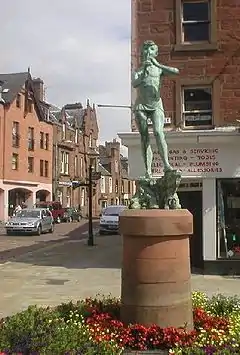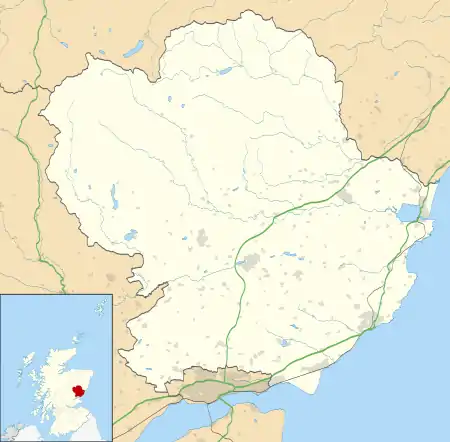Kirriemuir
Kirriemuir, sometimes called Kirrie or the Wee Red Toon,[2] is a burgh in Angus, Scotland. Its history reaches back to earliest recorded times, when it is thought to have been a major ecclesiastical centre. Later it was identified with witchcraft, and some older houses still feature a "witches stane" to ward off evil. In the 19th century, it was an important centre of the jute trade. The playwright J. M. Barrie was born and buried here, and a statue of Peter Pan stands in the town square.
{{Short description|Town in Angus, Scotland]]
Kirriemuir
| |
|---|---|
 Kirriemuir, Peter Pan Statue | |
 Kirriemuir Location within Angus | |
| Population | 6,120 (mid-2016 est.)[1] |
| OS grid reference | NO385535 |
| Council area | |
| Lieutenancy area | |
| Country | Scotland |
| Sovereign state | United Kingdom |
| Post town | KIRRIEMUIR |
| Postcode district | DD8 |
| Dialling code | 01575 |
| Police | Scotland |
| Fire | Scottish |
| Ambulance | Scottish |
| UK Parliament | |
| Scottish Parliament | |
History
The history of Kirriemuir extends back to the early historical period. It appears to have been a centre of ecclesiastical importance. The Kirriemuir Sculptured Stones, a series of late Pictish cross slabs, are on display at the Meffan Institute in Forfar and the Gateway to the Glens Museum in Kirriemuir.
The lands of Ummarchie lay in the feudal barony of Kirriemure – then in the Sheriffdom of Forfar – and were owned for centuries by the Lauder of the Bass family.[3] Alexander Lauder of Ummarchie, Co. Forfar, born about 1504 and a younger brother of Robert Lauder of the Bass (died 1576), appears in many documents and died at some time in 1580. In October of this year, his younger son Walter had murdered his father's Roman Catholic brother James in a religious dispute.[4] Walter was found guilty at Edinburgh on 15 December and beheaded.[5] The eldest son, another Alexander Lauder of Ummarchie, stood surety on 22 March 1600 in an Act of Caution in the Privy Council in a principal for 2000 merks for William Rynd of Kers, who was involved in violent armed feuds between the Lindsays and the Ogilvies.[6] Alexander Lauder of Ummarchie was still living in 1608.[7]
Kirriemuir has a history of witchcraft accusations dating back to the 16th century. Many older buildings have a witches' stane built in to ward off evil – a hard grey stone set into the local red sandstone of which they were built. A pond on the outskirts, known as the Witch Pool, was where supposed witches were thought to have been drowned, but in fact it was a millpond for the 19th-century Meikle Mill. Local amateur historians tend to think this referred to a "mickle" (small – it in fact means large)[8] mill, but the reference is to one of John Meikle's patented chaff-separating machines, based on ideas he picked up in the Netherlands. The adjacent "Court Hillock" was shown, during excavations for a housing development, to be no more than a spoil heap left after excavation and cleaning of the pond.
Though Kirrimuir's importance as a market town has diminished, its former jute factories (now manufacturing synthetics) recall its 19th-century importance as a centre of a home-based weaving industry.
Historic features near Kirriemuir include a carved Pictish stone known as the Eassie Stone. It was found in a burn near the village of Eassie.[9]
Kirriemuir claims the narrowest public footpath in Western Europe; Cat's Close, situated between Grant's Pend and Kirkwynd. It is a mere 40 centimetres (15.75 inches) wide.[10]
The family estate of Sir Hugh Munro, who created Munro's Tables of Scottish mountains over 3,000 ft. in elevation (which are now called "munros"), is also located near the town. So is Kinnordy House, the seat of the Lyells.
Kirriemuir Gingerbread was created by the baker, Walter Burnett, around 1900, though the recipe was sold to what is now Bell's Food Group, located in Shotts, in the 1940s.
Governance
Kirriemuir is represented within Angus Council by the Kirriemuir and Dean ward, from which three councillors are elected. As of 2012 these were: Ian Gaul (Scottish National Party), Ronnie Proctor (Scottish Conservative and Unionist), and Jeanette Gaul (Scottish National Party).[11]
Culture
The town has three museums: the Gateway to the Glens Museum, Barrie's Birthplace, and the Tayside Police Museum. There was once a museum of aviation, whose artifacts are now in the Richard Moss Memorial Collection at the Montrose Air Station Heritage Centre. There is a camera obscura, donated by J. M. Barrie, on the hill, offering views to the south and south-west and of the higher hills to the north. Also on the hill and offering views from its southern slopes is the town cemetery, where Barrie is buried in the family grave. There is a silver granite war memorial in the centre of the cemetery, a column surmounted by a kilted soldier looking down across the town and over the broad fields of Strathmore to the Sidlaws.
Every August a local music team holds a music festival, Live in the Den, featuring local guitar bands. In 2011 it was not held due to flooding.[12]
Setting
Kirriemuir consists mainly of two areas: Northmuir and Southmuir. It sits looking south towards Glamis and the Sidlaws over Strathmore (one of the most fertile fruit-growing areas in Scotland). Its position at the base of the Angus glens makes it an attractive centre for hill walking on nearby Munros, and for fishing, partridge, pheasant and grouse shooting, and deer-stalking. There is also an 18-hole golf course with views north to Glen Clova and Glen Doll.
Schools
Webster's High School is located in Southmuir; Northmuir and Southmuir each have a primary school. Northmuir's replaced Reform Street Primary School, which was in the town centre and demolished to build the Lyell Court Sheltered Housing complex. Southmuir's moved to new premises in 2002, which had been built as part of an extension to Webster's High School. The earlier Southmuir building (once the original Webster's Seminary) was destroyed by fire on 29 October 2006 and has since been demolished.
Parks
The town's two main parks lie in the Gairie Burn glen and on top of Kirriemuir Hill.
The Den can be split into two parts. The east Den lies to the east of Bellies Brae (The Commonty) and the west Den to the west of Bellies Brae. This park has a paddling pool. The Den is prone to flooding, as it lies in a deep valley. This last happened in December 2012. In the far west Den, there is a large Den Waterfall and the Cuttle Well.
The Hill with Neverland, or the Peter Pan Play Park as it is sometimes called, is located in Northmuir. This play park with a Peter Pan theme was laid out in November 2010. Smaller parks include Davidson Park in Southmuir and Martin Park off Slade Road.
Sport
Kirriemuir is home to the junior football club Kirriemuir Thistle. Although Kirriemuir lacks a senior team side, the nearest club in the Scottish Football League is Forfar Athletic in the neighbouring town, one of several Angus clubs to play in the official league system. Kirriemuir also has a wheeled sports area in Martin Park and an all-weather sports pitch at Webster's Leisure Centre adjoining Webster's High School.
Notable people
- J. M. Barrie, creator of Peter Pan and Rector of the University of St Andrews, was born in Kirriemuir. He wrote of this "wee red toonie" as "Thrums" in his novels Auld Licht Idylls, A Window in Thrums, and The Little Minister. "Red" refers to the reddish sandstone from which the town's older properties are built. The town became a minor Victorian tourism destination in response to Barrie's novels. His birthplace on the Brechin road is now a museum owned by the National Trust for Scotland.[13] A statue of Peter Pan stands in the town square in front of the old toll booth.
- Violet Jacob, poet and novelist, returned widowed from India in 1936, went to live in Kirriemuir, and died there in 1946.[14]
- Scott McKenna, professional footballer playing for Nottingham Forest and Scotland, grew up in Kirriemuir and attended Websters High School.[15]
- David Niven, actor, claimed Kirriemuir as his birthplace, but was actually born in London.[16]
- Bon Scott, vocalist of AC/DC, was born at the maternity hospital in nearby Forfar in 1946 and lived in Kirriemuir until 1952, when his family emigrated to Australia. A plaque to his memory stands in Cumberland Close.[17] On 26 January 2016, town officials approved plans for a statue of Scott in the Bellies Brae car park. This was unveiled by former AC/DC bass player Mark Evans in April 2016 during the town's annual "Bonfest" event.[18]
- Sir David Wilkie, surgeon, was born here in 1882. He befriended Barrie in 1930, when he became Chancellor of the University of Edinburgh, due to their common home town.[19]
- Victoria Cross awardees: Captain Charles Lyell, Corporal Richard Burton, and Private Charles Melvin resided in Kirriemuir.[20]
Twin towns/sister cities
References
- "Mid-2016 Population Estimates for Settlements and Localities in Scotland". National Records of Scotland. 12 March 2018. Retrieved 30 December 2020.
- "Kirriemuir". Gazetteer for Scotland. Retrieved 1 February 2021.
- Calendar of the Laing Charters 854–1837, ed. Rev. John Anderson, Edinburgh, 1899, No. 317, pp. 80–81.
- Register of the Privy Seal of Scotland 1575–1580, ed. Gordon Donaldson, D.Litt., Vol. vii, Edinburgh, 1966, No. 2651, p. 431.
- Pitcairn's Criminal Trials.
- The Register of the Privy Council of Scotland, ed. David Masson, LL.D., vol. vi, 1599–1604, Edinburgh, 1884, p. 639.
- Register of the Privy Council of Scotland 1607–1610, ed. David Masson, LL.D., Edinburgh, 1887, Vol. viii, p. 162.
- SND: Mickle.
- "Eassie Stone". The Megalithic Portal. Retrieved 5 September 2019.
- Captioned photograph.
- Election 2012 Results Ward 1 – Kirriemuir & Dean, archived from the original on 7 May 2012, retrieved 9 May 2012
- Inglis, Marjory (22 August 2011). "'A complete swamp'–flooding forces cancellation of Kirriemuir music event Live in the Den". The Courier. Archived from the original on 30 July 2012. Retrieved 23 November 2011.
- Scotland, National Trust for (4 September 2019). "J M Barrie's Birthplace". National Trust for Scotland. Retrieved 5 September 2019.
- Carol Anderson: "Jacob [née Kennedy-Erskine], Violet Augusta Mary Frederica", Oxford Dictionary of National Biography (Oxford, UK, 2004) Retrieved 1 April 2018.
- "Scott McKenna". Aberdeen FC. Retrieved 5 September 2019.
- Morley, Sheridan (1985). The Other Side of the Moon. London: Weidenfeld and Nicolson. ISBN 0-340-39643-1.
- "Rock tribute to AC/DC star Scott". Crabsody in Blue. 17 May 2008. Retrieved 7 August 2008.
- "AC/DC singer's statue unveiled". BBC. 1 May 2016. Retrieved 5 September 2019.
- "Archived copy" (PDF). Archived from the original (PDF) on 2 March 2016. Retrieved 17 February 2016.CS1 maint: archived copy as title (link)
- Brown, Graham. "Angus shows way as plans for Victoria Cross memorials unveiled". Thecourier.co.uk. DC Thomson. Retrieved 20 August 2015.
- "National Commission for Decentralised cooperation". Délégation pour l'Action Extérieure des Collectivités Territoriales (Ministère des Affaires étrangères) (in French). Archived from the original on 4 October 2013. Retrieved 26 December 2013.
External links
![]() Media related to Kirriemuir at Wikimedia Commons
Media related to Kirriemuir at Wikimedia Commons
